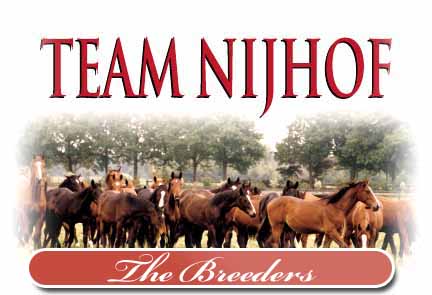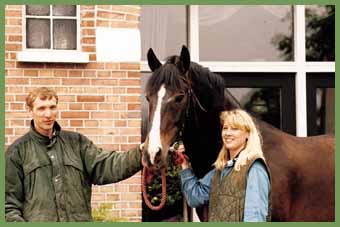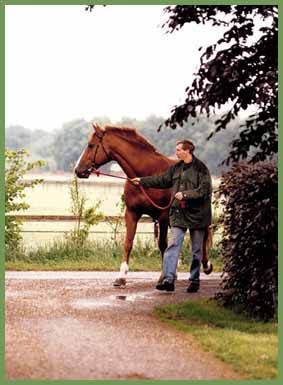Breeding tomorrow’s horses
Chris Hector intervews Jeanette Nijhof.
Photos by Roz Neave
Everything about the Nijhof Stallion Station is professional, even Jeanette Nijhof’s map is so brilliantly detailed that we have no troubles finding our way down the tiny roads to one of the world’s largest stallion operations. As Jeanette explains, her family is continually having to find new, better stallions to service an increasingly sophisticated market.
“We aim to provide the breeders with the best possible material. It is no good for us to stand a stallion who is poor – you have to put that stallion with a rider, as the stallion owner you must buy foals to support that stallion, you must make a brochure, it costs you quite a lot of money and with a poor stallion, you are a thief of your own wallet. If it is not a top class stallion then you had better sell it, so you don’t fool yourself and the breeders.”
The Dutch Performance breeding industry has come a long way in a very short time, largely due to the efforts of individuals like Jeanette’s father, Henk Nijhoff.
“My grand-father had a dairy farm, which my father was supposed to take over, but he had back problems when he was a about twenty years old. They told him to sell the farm because the work was too tough for his back. He was very poorly insured so he would not get enough to live on, so he decided to switch to horses. About thirty years ago, he went to a lot of courses on how to judge horses, course building, riding instructing.”
“In the beginning we bought young stallions, trained them, got them approved, then sold them for quite a lot of money. In the end the tax department was taking too much, they were saying, that’s very nice, thank you very much. So then we decided to lease the stallions out.”
“Voltaire was one of the first stallions we leased out rather than sold. So that was really easy to work out. So many mares, so much for the work of the stallion station, so much for the stallion owner – thank you very much.”
“In the beginning the stallions were ‘double purpose’ horses, C level jumping and C level dressage. The stallion had to be a good mover, with good conformation, then after the test they were approved stallions. In the past ten years we have started to see the specialisation – the stallion is a good jumper or a good dressage horse, but for quite a long time the aim was the dual purpose horses.”
Was Voltaire the first really great horse your family stood?
“Well they didn’t think he was such a great horse. There were thirteen stallions selected that year, and he was the last. They said, he represents new bloodlines and we like that, but he is not really spectacular but we’ll give him a chance. He was approved but partly because of his pedigree, but he was nearly not a stallion. He was kicked out of Oldenburg, that’s how my father and Jan Greve bought him. They were looking all over Germany for young stallions, then the director of one of the studs, said we must sell this horse, he jumps very well but they didn’t approve him because he was too little. He had a really bad hoof crack as well – he was not so expensive.”
“In his first year he had only three mares for one foal! One mare didn’t come in foal, one foal died, so there was only one Voltaire baby, it was a mare – Jan Greve still has her.”
“In the past few years we have had problems with Voltaire’s semen. We successfully treated one bacteria, then he got another one. The Professor who treated it said it was like a fish pond where you have different bacteria keeping in balance, so we treated one, and the other got up, the balance was upside down… for two years we used a lot of frozen semen because we couldn’t use the fresh.”
“Now it is very good again, he has a very good pregnancy rate at the moment – he is twenty years old, he might last another ten years, you can never know. Luckily we have a lot of young stallions coming on.”
You have your own mares?
“We do have mares but we try to focus on one subject, and that really is the stallion business. We buy and breed between 40 and 60 foals a year – some from France, from Germany, we go everywhere to get fresh bloodlines. We try to find the new bloodlines before everyone else knows about them. If there is a really good four year old stallion in France, then you want a foal, so that by the time he is six or seven and everyone finds out he is good, you already have a young one.”
“We keep the young horses here and we select them at two and a half, three years, and put the ones we select up before the commission. The ones that become stallions, we keep, depending on how good they are, the ones that do not make it as a stallion, we sell as sport horses – from last year we have only four left.”
“We have considered getting a rider of our own, and keeping some of the talented horses, but we would have to have another indoor arena, another truck, another groom – for maybe only one or two horses that are worth keeping. If we think a horse is really really special, we keep it and give it to our rider, Peter Geerink.”
How many stallions do you have?
Jeanette laughs… “I can’t really tell you! About twenty five, about fifteen in Holland. We have some stallions breeding in Oldenburg, a few in Denmark, four or five in Belgium – it’s good, it makes new contacts.”
You don’t care which country your stallions come from?
“As long as the horse is good, and the pedigree is good. We try to keep the best, and find the best. We have bought frozen semen of Olisco and Cruising, don’t use just your own stallions, but also interesting other stallions. The French are really chauvinistic, they don’t breed to other bloodlines, and the Germans are a bit like that too – but in Holland and in Belgium, we try to import the best bloodlines from all over the world.”
“You can make some very nice mixtures – for instance the Holsteiners that are very scopey and very good to ride, you can mix that with the French bloodline that is very difficult with a bad mouth, and you can come up with a very good mixture.”
Standing stallions in Europe must be a very competitive business…
“More and more people want to breed their mares to the famous stallions. In the past it was very popular to breed to a stallion that had just finished the 100 day testing, these new stallions would get 200 to 300 breedings. Now the younger stallions get less mares and more go to the famous ones. You have to make sure you have got good stallions. You’ve got to believe in your stallion, even if the judge does not agree, if you really think the stallion is good, you should really promote it.”
What are the currently fashionable stallions?
“Voltaire is very popular, Calvados is very popular, especially with the riders because his children jump very well, Burggraaf is going very well.”
In the dressage stallions?
“I think Flemmingh is very popular, Ferro, the black stallion, is very popular. Cocktail was very popular, but his semen is not so strong so he can’t have too many mares. The one thing we need is another good dressage stallion, but you don’t want any stallion, you don’t want to fool the breeders. It’s hard not to get anxious because dressage is so popular, but we keep looking.”
“Jumping is so much easier to see, with dressage you never know how good they will get until you have trained them and they either do piaffe or passage or they don’t. You can have a three year old and it might look very spectacular but once you start riding it, it becomes very difficult, or it finds it hard to collect. We put Cocktail with Anky van Grunsven when he was a four year old, and when he was six, she would say ‘he’ll never learn to passage’. But she kept training until it was one of his best gaits.”
For a stallion to be interesting to the breeders is it necessary for him to go out and compete internationally?
“Sure. The qualities are inheritable, so if they can do it themselves, they can probably give it on to their children. Look at Nimmerdor or Ahorn or Voltaire, all these stallions jumped at an international level themselves and their children do too. It’s been less than ten years, perhaps really only five years, that it has been popular to put stallion the into sport. Before they were breeding stallions, and they also produced jumpers – but you don’t know, if they had competed they might have jumped very well.”
“That’s a bit of a problem with dressage breeding – dressage is so popular that a lot of mares go to dressage stallions, and they have a very low score for jumping, then if the foal is not a dressage horse, and not a jumper, then you have nothing. Out of the jumper lines we bred a lot of dressage horses – Cocktail has jumper lines, Ferro has jumper lines, Flemmingh has jumper lines. So we get good dressage horses out of jumper lines, but I am not to sure about the other way around. It might be a little bit scary in the future if these so-called dressage horses don’t produce dressage horses, they definitely will not produce jumpers, and that’s dangerous. It’s too young the dressage breeding – maybe it works, maybe it doesn’t, we’ll have to see. I think in Holland they will start again to approve some good moving stallions of jumper lines, to see if they can make dressage horses.”
All your breeding here in Holland is with chilled semen, never with live cover?
“Always chilled. It is very good, very clean, you don’t infect the stallions. We collect the semen in the morning, and we have a very good courier service here in Holland, they have eleven cars and they all do a tour in the morning, then come to a central place, they exchange the semen and go back to the same place in the afternoon. If you order semen before nine in the morning, it gets to your place before three or four in the afternoon. They have little refrigerators in the cars.”
Frozen semen?
“It’s getting better but everyone wants results, people were very scared of frozen semen, they didn’t know how to deal with it. We do a lot of frozen semen, we had to last year with Voltaire. We had a very good result with Voltaire because you have to work very carefully, very close to ovulation. If the mare is okay, the chances with frozen semen are much better. With fresh semen, they say, ‘oh there’s a nice follicle, put some semen in today’. Then the vet comes back the next day, or it’s still there, another insemination. Here in Holland we are doing a lot of research – what sort of semen works best, exactly how much semen you really need. In a few years I think frozen semen will work very well. We do a lot of testing on our horses, all our stallions have been x-rayed for the past ten years, we breed very healthy horses and that is why they are so popular.”
How do you find the good match of mare and stallion?
“You really have to wait and see the foal, and see how the genes work. For us that is very important. First the stallion has to be approved, then he has to jump very well, or be good at dressage, but then he has to breed well. It’s no good if he jumps really well but doesn’t pass his nice qualities on to his children. Sometimes you have a stallion who is not jumping so well himself but really throws nice children. That’s another thing we do well in Holland, the foals must be inspected and then the records are kept of the offspring in sport, so the breeder gets a lot of information on the stallions. Breeding is always going to be hard work but the more information you can get the better it is… And that’s our challenge, producing better horses all the time!”
This article first appeared in The Horse Magazine in January 1999



